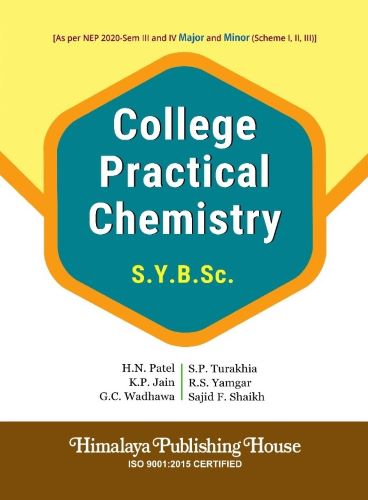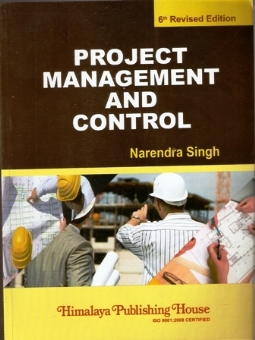We are immensely pleased tp present the Twenty-Eighth edition of our “College Practical Chemistry” Book for S.Y.B.Sc., students, of University of Mumbai from the academic year 2025-26.
This revised edition is in accordance into the National Education Policy (NEP-2020) and the updated syllabus of the University of Mumbai. It emphasizes experiential learning conceptual clarity and skill based education aligning with the vision of fostering scientific temper, critical thinking and practical competence of NEP-2020.
All the experiments are written as prescribed by the Syllabus Committee of University of Mumbai and experiments are divided on the basis of Semesters III and IV.
Contents –
PHYSICAL CHEMISTRY
(I) Conductometry
(1) To verify Ostwald’s dilution law for weak acid conductometrically.
(2) To determine solubility of sparingly soluble salts (any two) conductometrically.
(3) To determine the amount of HCl and CH3COOH in a mixture by conductometric titration with sodium hydroxide solution.
(II)Potentiometry
(1) To determine the amount of HCl in the given sample potentiometrically.
(2) To determine the standard reduction potential of Ag/Ag+ using Nernst equation.
(3) To determine standard e.m.f. and standard free energy change of Daniel Cell potetntiometrically.
(4) To determine G0 and equilibrium constant for cell reaction in the cell set up with copper and silver electrodes.
(5) To determine the Solubility product and solubility of AgCl potentiometrically using chemical cell.
(III) Colorimetry
(1) To determine λmax and molar extinction coefficient for potassium permanganate solution using a photometer and hence to determine the concentration of potassium permanganate in a given solution.
(2) To determine the amount of Fe (III) present in the given solution by using Salicylic acid by colorimetric titration (Static Method) { λ max = 525 nm}
(IV) pH metry
(1) To determine the amount of strong acid present in a given solution by titration with a strong base using a pH meter.
(2) To determine acidic and basic dissociation constants of an amino acid and hence the iso-electric point
(V) Chemical Kinetics
(1) Determination of energy of activation of acid-catalyzed hydrolysis of methyl acetate.
(2) To investigate the reaction between K2S2O8 and KI with equal initial concentrations of the reactants.
(VI) Phase Equilibria
(1) To determine Critical Solution Temperature (CST) for phenol-water system.
(VII) Partition Coefficient
(1) Determination of partition coefficient of I2 between organic solvent and H2O.
(VIII) Viscosity
(1) To determine molecular weight of high polyvinyl alcohol by viscosity measurements.
ANYLITICAL CHEMISTRY
(IX) Tools of Analytical Chemistry – I
(a) Analytical glass wares like burettes, pipettes, Standard flasks, and separating funnels.
(b) Weighing tools such as two pan balance and monopan balance, digital balances:
(c) Incineration devices: Burners, Electrical Incinerators, Muffle Furnace,
(d) Drying Devices: Hot Air Oven, Microwave Oven, Desiccators, Vacuum desiccators
(e) Monochromators, Filters, Sample holders, Prisms, Diffraction Gratings, Photo emissive cells, Photomultiplier tubes
(X) Tools of Analytical Chemistry – II
(a) Filtration Flasks, Funnels, Separating Funnels, Distillation apparatus, Vacuum Distillation assembly, Centrifuge machine, Electrophoresis apparatus.
(b) Development chamber for chromatography
(c) Electrodes like Reference Electrodes and Indicator Electrodes (with respect to care and maintenance).
(d) Conductivity cell (with respect to care and maintenance).
(e) Combined Glass electrode (with respect to care and maintenance).
(f) Types of Salt Bridges and preparation of any one or use of salt bridge, its effect on the potential of a given electrode/cell.
(XI) Colorimetry/Spectrophotometry
(1) Determination of copper ion in the given solution calibration curve method.
Determination of copper ions as an ammine complex in the given solution is obtained by the calibration curve method.
(2) To determine the concentration of chromium (VI) in the given solution as dichromate by the least squares method spectrophotometrically.
(3) Estimation of the concentration of Iron by using 1,10-Phenanthroline.
(XII) pH metry
(1) Determination of buffer capacity of acid buffer and basic buffer.
(XIII) Conductometry
(1) Estimation of given weak acid with strong base by conductometric titration.
Estimation of acid content by conductometric titration with strong base.
(XIV) Potentiometry
(1) Estimation of Fe (II) in the given solution by titration against K2Cr2O7.
(XV) Volumetric/Estimations
(1) Estimation of drugs – Estimation of aspirin.
(2) Estimation of chloride content in the given saline sample by using silver nitrate.
(3) Estimation of Mg content in talcum powder by Complexometry by using standard solution of EDTA.
(4) Determination of COD of given water sample
(5) Estimation of copper by EDTA method using fast sulphone black F indicator.
(6) Determination of hydrogen peroxide in terms of (i) volume strength (ii) grams per litre.
(7) Titration of sodium thiosulphate with potassium dichromate (to study transfer of electrons)
(8) Estimation of carbonate and non-carbonate hardness of water.
(XVI) Paper Chromatography
(1) Separation of Cation Fe (III), Ni (II) and Cu (II) in a sample.
(XVII) Solvent Extraction
(1) Separation of a solute between two immiscible solvents to determine the distribution ratio and/or extraction efficiency. (Solutes could be as their aqueous solutions and the organic solvent ethyl acetate) Suggested solute for the distribution study: Fe (III) in aqueous solutions. (The learner is expected to learn the technique of solvent extraction by using a separating funnel, method to estimate the concentrations of the solute distributed in the two immiscible phases, determination of the extraction efficiency).
INORGANIC CHEMISTRY
(XVIII) Inorganic Preparations
(1) tri (thiourea) cuprous(I) chloride
(2) tris ethylene diamine Ni(II) thiosulphate.
(3) sodium hexa nitro cobaltate (III)
(4) tetraamine copper (II) sulphate
(5) bis (dimethylglyoximato)Ni(II)
(6) bis (acetlyacetonato) Cu(II)
(7) Potassium trioxalato Ferrate K3[Fe(C2O4)3].3H2O
(XIX) Complexometric Titrations:
(1) Estimation of total hardness of water.
(2) Investigation of the reaction between copper sulphate and sodium hydroxide.
(3) Volumetric Analysis / Redox titration : Estimation of amount of Iron present in the given ferric alum solution.
(4) Iodometric titration – Estimation of Cu(II) by using sodium thiosulphat.
(5) Determine the amount of sodium carbonate and sodium hydroxide present together in the given solution.
(XX) Gravimetry
(1) Nickel (II) as Ni(dmg).
(2) Barium as BaCrO4.
(3) Calculate the percentage composition of the mixture of Na2CO3 and NaHCO3
(XXI) Identification of Cations: (minimum 5)
(1) Identification of cations in a given mixture and analytical separation of mixture [from a mixture containing not more than two of the following; Pb(II), Ba(II), Ca(II), Sr(II), Cu(II), Cd(II), Mg(II), Zn(II), Fe(II), Fe(III), Ni(II), Co(II), Al(III), Cr(III)]
ORGANIC CHEMISTRY
(XXII) Qualitative Analysis of Bifunctional Organic Compounds
(1) Preliminary examination
(2) Solubility / miscibility profile
(3) Detection of elements C, H, (O), N, S, X.
(4) Detection of functional groups
(5) Determination of physical constants (M.P/B. P)
Solid or liquid compounds containing not more than two functional groups from among the following classes may be given for analysis Suggested Compounds Carboxylic Acids: Salicylic acid, Acetyl aalicylic acid, o-chloro benzoic acid, o or m or p-nitro benzoic acid, anthranilic Acid Phenols: o or m or p-nitro Phenol Amines: o or m or p-nitro aniline or p-toluidine Monofunctional Compound List: Aldehydes: Benzaldehyde Ketones: Benzophenone, acetophenone Esters: Methyl acetate, Ethyl acetate, Ethyl benzoate Alcohols: Propanol, butanol, benzyl alcohol Ethers: Anisole Amides & anilides: Urea, thiourea, benzamide, acetanilide, benzanilide
(XXIII) Short Organic Preparations and Their Purification:
(1) Cyclohexanone oxime from cyclohexanone.
(2) Glucosazone from dextrose or fructose.
(3) Tribromoaniline from aniline.
(4) β-naphthylbenzoate.
(5) m-Dinitrobenzene from nitrobenzene.
(6) Phthalic anhydride from phthalic acid by sublimation.
(7) Acetanilide from aniline.
(8) p-Bromoacetanilide from acetanilide.
(9) Iodoform from acetone.
(Note: Any eight preparations)
Appendices






